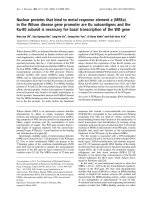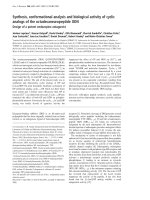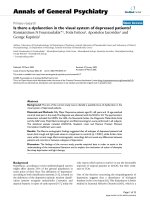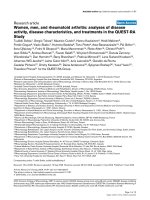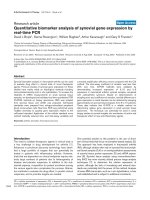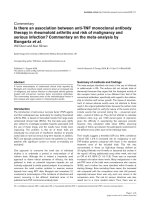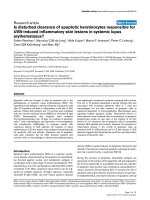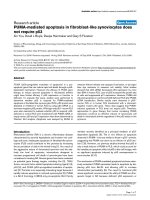Báo cáo y học: "Is cost-effectiveness analysis preferred to severity of disease as the main guiding principle in priority setting in resource poor settings" doc
Bạn đang xem bản rút gọn của tài liệu. Xem và tải ngay bản đầy đủ của tài liệu tại đây (298.04 KB, 11 trang )
BioMed Central
Page 1 of 11
(page number not for citation purposes)
Cost Effectiveness and Resource
Allocation
Open Access
Research
Is cost-effectiveness analysis preferred to severity of disease
as the main guiding principle in priority setting in resource poor
settings? The case of Uganda
Lydia Kapiriri*
1
, Trude Arnesen
2
and Ole Frithjof Norheim
1
Address:
1
Centre for International Health and Department of Public Health and Primary Health Care. University of Bergen. Ulriksdal 8c, N-5009.
Bergen. Norway and
2
Fafo Institute for applied International Studies. P.O. Box 2947, Tøyen. NO-0608 Oslo. Norway
Email: Lydia Kapiriri* - ; Trude Arnesen - ; Ole Frithjof Norheim -
* Corresponding author
Cost-effectivenesshealth care rationingseverity of diseasepriority settingand developing countries
Abstract
Introduction: Several studies carried out to establish the relative preference of cost-effectiveness of interventions and
severity of disease as criteria for priority setting in health have shown a strong preference for severity of disease. These
preferences may differ in contexts of resource scarcity, as in developing countries, yet information is limited on such
preferences in this context.
Objective: This study was carried out to identify the key players in priority setting in health and explore their relative
preference regarding cost-effectiveness of interventions and severity of disease as criteria for setting priorities in Uganda.
Design: 610 self-administered questionnaires were sent to respondents at national, district, health sub-district and
facility levels. Respondents included mainly health workers. We used three different simulations, assuming same patient
characteristics and same treatment outcome but with varying either severity of disease or cost-effectiveness of
treatment, to explore respondents' preferences regarding cost-effectiveness and severity.
Results: Actual main actors were identified to be health workers, development partners or donors and politicians. This
was different from what respondents perceived as ideal. Above 90% of the respondents recognised the importance of
both severity of disease and cost-effectiveness of intervention. In the three scenarios where they were made to choose
between the two, a majority of the survey respondents assigned highest weight to treating the most severely ill patient
with a less cost-effective intervention compared to the one with a more cost-effective intervention for a less severely ill
patient. However, international development partners in in-depth interviews preferred the consideration of cost-
effectiveness of intervention.
Conclusions: In a survey among health workers and other actors in priority setting in Uganda, we found that donors
are considered to have more say than the survey respondents found ideal. Survey respondents considered both severity
of disease and cost-effectiveness important criteria for setting priorities, with severity of disease as the leading principle.
This pattern of preferences is similar to findings in context with relatively more resources. In-depth interviews with
international development partners, showed that this group put relatively more emphasis on cost-effectiveness of
interventions compared to severity of disease. These discrepancies in attitudes between national health workers and
representatives from the donors require more investigation. The different attitudes should be openly debated to ensure
legitimate decisions.
Published: 08 January 2004
Cost Effectiveness and Resource Allocation 2004, 2:1
Received: 30 June 2003
Accepted: 08 January 2004
This article is available from: />© 2004 Kapiriri et al; licensee BioMed Central Ltd. This is an Open Access article: verbatim copying and redistribution of this article are permitted in all
media for any purpose, provided this notice is preserved along with the article's original URL.
Cost Effectiveness and Resource Allocation 2004, 2 />Page 2 of 11
(page number not for citation purposes)
Introduction
Priority setting in health occurs at different levels and can
be defined as distribution decisions involving clear and
direct limitations of access to beneficial care or as a proc-
ess of determining how health care resources should be
allocated among competing programmes or people [1-3].
This can be implicit whereby the decisions and reasons for
those decisions are not clearly expressed or explicit where
they are clearly stated [4-6]. In the latter case, criteria can
be used to facilitate the process. Several criteria for priority
setting in health have been developed [7]. However, cost-
effectiveness of interventions and severity of disease are
some of the most widely discussed criteria. They are also
some of the cardinal principles laid down in the Ugandan
national health policy [8].
Cost-effectiveness compares cost per outcome of different
interventions [9,10]. Net economic cost is used as a
numerator and improved health as a denominator and
the lower the ratio the more preferred the intervention.
Effects can be evaluated in terms of the impact of an inter-
vention on mortality, morbidity, or quality of life. Cost-
effectiveness analysis allows for comparison between
interventions and makes allocation of resources explicit.
Application of this procedure ensures that the maximum
possible expected health benefit is realised, subject to
whatever resource constraint is in effect [10,8,11].
Conversely, severity of disease has a variety of interpreta-
tions. We use the concept of the degree to which a condi-
tion affects a person's or population's health by causing
death, handicap, disability, any kind of suffering or pain.
Others use the concept of burden of disease measured in
terms of Disability Adjusted Life Years (DALYs) which is a
composite measure that combines both morbidity, mor-
tality and other values in one single outcome measure
[12,11]. Severity of disease is an important concern in
egalitarian approaches to priority setting [13].
Which one of the two criteria should be the most impor-
tant criterion when setting priorities? In the extreme, a sys-
tem that considers only cost-effectiveness would channel
all its resources to people who happen to have the best
potential to benefit from treatment in order to ensure effi-
cient use of meagre resources [9,14]. However, some stud-
ies have shown that using cost-effectiveness as a major
criterion may not respond to what people want or expect
[11,13,15,16]. Conversely, a system that considers only
severity may satisfy societal concern for the severely ill,
but may lead to inefficient use of resources by overlooking
the potential for patients to benefit from the interventions
and ignoring costs. These factors are even more crucial in
contexts of extreme resource scarcity [17-20].
Attempts to prioritise solely on the basis of cost-effective-
ness as the major guiding principle, like the first plan in
the state of Oregon, have not had much success in practice
[21]. This is partly because of the ethical tensions between
the maximisation of health benefit and societal concerns
for the severity of disease [22]. Studies done in Australia
and Norway have also shown societal preference for sever-
ity of disease as opposed to cost-effectiveness of interven-
tion, as main criteria for priority setting [23-25].
Preferences may vary depending on culturally constructed
values and norms in each population. Patterns of prefer-
ences may also be different in deprived settings where
decision-makers are accustomed to having insufficient
resources to treat everybody and having to exclude some
beneficial treatments [8,26]. Preferences may also differ
with the level of priority setting [27,28]. It is thought that
people far removed from patients may have different val-
ues compared to those held by physicians, patients and
their families [29,30].
Most of the studies examining the relative importance of
cost-effectiveness of intervention compared to severity of
disease have been carried out in developed countries. This
debate may seem far removed from the developing coun-
tries' contexts, such as Uganda where most severe diseases
also have interventions that are cost-effective [30]. Still,
the upsurge of non-communicable diseases, the resource
demands due to the HIV/AIDS epidemic and the limited
budgets for the health sector, makes this a relevant
discussion.
Study Objectives
1. To establish the relative preferences regarding cost-
effectiveness of interventions, and severity of disease as
main criteria for setting priorities in Uganda.
2. To identify the perceived actual and ideal actors in pri-
ority setting in health.
Methods
We carried out a qualitative pre-survey study where eight
group discussions were convened. Participants were
homogeneous and included health workers, district
planners, patient groups and the general population.
These were asked what values they thought were impor-
tant in priority setting in health. After a brain storming
and deliberations, the values mentioned were ranked in
order of perceived importance by consensus. All the
groups, ranked severity of disease as the most important
criteria, with the exception of the district planners' group,
who ranked costs and effectiveness of care as the most
important (Table 1).
Cost Effectiveness and Resource Allocation 2004, 2 />Page 3 of 11
(page number not for citation purposes)
We also carried out in-depth interviews with international
development partners and national level government
officers who identified health workers as the main actors
in priority setting and we therefore let this group form the
biggest proportion of our survey respondents.
The survey was carried out in Uganda. We included
respondents at national level and from four districts (out
of the 49 districts), namely Kampala, Adjumani, Hoima
and Kamuli. These were purposefully selected to represent
the northern, eastern, western and central geographical
regions. A sample size of 610 was calculated (assuming a
response rate of 50%). Respondents included health plan-
ners and workers involved in priority setting at national,
district, health sub-district and facility levels, and repre-
sentatives from the general population. At national level,
a list of all health workers was obtained and the heads of
the different directorates included. In case the selected
person was not available, the questionnaire was given to
the person next in charge. At the national teaching hospi-
tal, respondents included senior house officers and stu-
dent nurses. In the district hospitals, questionnaires were
given to health workers working in each of the four major
departments (medicine, paediatrics, surgery and obstet-
rics and gynaecology), with instructions to distribute
them randomly between the doctors and nurses. In the
health centres, all health workers were included. All mem-
bers of the district local council and district health team
were included. The rest of the questionnaires were strate-
gically by virtue of the respondents' having some knowl-
edge of the subject we were exploring.
Respondents were reminded three times, at intervals of
one week, after which non-response was registered.
Study Focus
To identify the key actors, survey respondents were pro-
vided with the list of key actors that had been mentioned
by the informants in the in-depth interviews, and were
first asked to indicate the degree of importance attached to
the different actors using ranks. The respondent could dis-
tinguish between their perception of the actual and ideal
situation with the following statements:
1. In my opinion, the following are (at present) the main
actors in priority setting in health.
2. In my opinion, the following should, ideally, be the
main actors in priority setting in health.
The second question was asked in order to identify those
people the respondents perceived to be legitimate actors
in priority setting. The mean rank derived for a category of
actors was taken as the overall rank for the category in the
whole study population.
We then explored the general view of the consideration of
cost-effectiveness of interventions or severity of disease by
asking whether or not the respondents felt they were
important for priority setting. Respondents indicated their
degree of agreement on a six-point scale.
We further examined the respondents' preferences using
three different scenarios based on a study by Nord [31].
We assumed that both patients, A and B, in the scenarios
had similar personal characteristics and that with their
given treatment, both patients would completely recover
to their full health (Figure 1).
Table 1: Relative importance of cost-effectiveness and severity of disease: sample results from the qualitative study
Ranks Groups
Patients with HIV and
Hypertension
General population Out-patients Health workers District planners
1 Severity Severity Severity Severity Cost of care
2 Cost of care Number affected Number affected Affects children Effectiveness of
treatment
3 Conditions that are
difficult to manage
Affects disadvantaged Community felt problem Cost of care Community felt problem
4 Equity Affects development Affects children Number affected Severity
5 Number affected Ease of intervention Gender Availability of effective
treatment
Consequences of
problem
6 Equality Community felt problem Availability of effective
treatment
Benefit of intervention Ease of intervention
7 Availability of Effective
treatment
Cost of care Equity Consequences of
condition
Affects children
8 Person responsible for
cause
Effectiveness of
intervention
Preventable Equity Affects disadvantaged
The values are reported as mentioned in the group discussions
Cost Effectiveness and Resource Allocation 2004, 2 />Page 4 of 11
(page number not for citation purposes)
Scenario 1: Imagine you are a medical officer in a health
unit and you receive two patients A and B. Patient B is
severely ill while patient A is not so ill. Both patients
require treatment that is equally cost-effective. They both
can be restored to full health with their treatment. If you
are only able to treat one of the two patients, which one
would you treat, A or B?
Scenario 2: Imagine you are a medical officer in a health
unit and you receive two equally severely ill patients A and
B. Patient A requires a more cost-effective treatment, while
patient B requires treatment which is less cost-effective.
They both can be restored to full health with their treat-
ment. If you are only able to treat one of the two patients,
which one would you to treat, A or B?
Scenario 3: Imagine you are a medical officer in a health
unit and you receive two patients. Patient B is severely ill
but needs treatment that is less cost-effective, while
patient A is not severely ill but requires treatment, which
is more cost-effective. They both can be restored to full
health with their treatment. If you are only able to treat
one of the two patients, which one would you to treat, A
or B?
Analysis
Survey data were analysed using SPSS. The mean rank was
used for the question about actors in priority setting. For
Schematic presentation of the three scenariosFigure 1
Schematic presentation of the three scenarios. Cost-effectiveness of A=B in Scenario 1, A>B in Scenario 2 and 3.
A B A B A B
Full Health
Scenario 1 Scenario 2 Scenario 3
Table 2: Demographic characteristics of the survey respondents
(n= 413)
Characteristic Frequency (%)
Age
<25 7
25–35 49
36–45 33
46–55 9
55+ 1
Designation
Medical doctor 33
Allied health worker* 46
Administrator 7
Politician 2
Other** 13
Level of work
National 9
District 6
Health facility 51
Teaching hospital 16
UN 3
Other** 14
Does respondents consider priority setting as their
work?
Yes 88
No 12
* Other health workers at health facility level who are not doctors
**Other were representatives from the general public
Cost Effectiveness and Resource Allocation 2004, 2 />Page 5 of 11
(page number not for citation purposes)
the relative importance of cost-effectiveness and severity,
we first derived the frequencies of respondents' degree of
acceptance of the two criteria for priority setting in
Uganda.
We then dichotomised the six-point response scale such
that respondents who strongly agreed or agreed with a cri-
terion were re-coded as agree and those that disagreed or
strongly disagreed were re-coded as disagree. The rest of
the responses were re-coded as missing. For the three sce-
narios, after analysing the frequencies, we considered only
specific responses: Patient A, Patient B. Non-respondents
and respondents who preferred treatment of both patients
(about 30%) were re-coded as missing because of small
numbers. We also dichotomised the demographic charac-
teristics. Age was re-coded as <= 35 years; > 35 years, des-
ignation as health worker; Non-health worker,
Respondent consider priority setting as part of their daily
duties: Yes; No, and Level of work as District and national
planning level; Health facility level. Respondents who did
not fit in these categories were re-coded as missing. We
tested for associations between the characteristics of the
respondents using the chi-square test. Interactions
between these were adjusted for (using multiple logistic
regression analysis), when testing for associations
between the respondents' characteristics and their degree
of agreement with the consideration of the different crite-
rion for priority setting and their choices in the three sce-
narios. Odds ratios and confidence intervals are reported.
Results
Of the 610 questionnaires sent out, 413 (67.7%) were
retrieved. The lowest response rate was from the northern
region, in which there are ongoing acts of war. Fifty one
percent of the survey respondents were health workers at
health sub-district level. Respondents not directly
employed in the health sector (politicians, administra-
tors, other civil servants and the general population)
accounted for 28% of the study population. The mean age
of the respondents was 30.4 years (Table 2).
Using the mean rank given to the actors by the 413 survey
respondents, the current actors in priority setting in
health, in order of perceived role played included health
professionals, donors and government officers respec-
tively (Fig. 2). Similar results were found in the in-depth
interviews. However, in response to which the ideal actors
should be, health professionals maintained their first
position, while donors and politicians exchanged ranks
with patients and the public respectively.
Relative importance of cost-effectiveness and severity of
disease
In response to the question whether cost-effectiveness
and/or severity should be considered when setting priori-
ties in health, most of the respondents (63%) strongly
agreed that both were important criteria (Table 3). About
8% either disagreed or were undecided.
There were significant associations between some of the
respondents' characteristics. Respondents above 35 years
were less likely to be involved in priority setting at
national or district levels than those below 35 years. The
former were also less likely to consider priority setting to
be part of their duties. Non-health workers were less likely
to consider priority setting in health as part of their duty
(Table 4). We controlled for these associations in the fur-
ther analyses.
The regression analysis (Table 5), showed that signifi-
cantly more people involved in priority setting supported
the consideration of cost-effectiveness as compared to
those not involved in priority setting (OR= 8.9, p <
0.001).
The in-depth interviewees, who were mainly donors and
national level government officers, also expressed a pref-
erence for cost-effectiveness of interventions over severity
of disease when asked about their guiding principle in pri-
ority setting.
In response to the three different scenarios where we tried
to directly compare cost-effectiveness and severity
through simulated situations, the majority of the survey
The actual and ideal rank given to various stakeholders' role in priority settingFigure 2
The actual and ideal rank given to various stakeholders' role
in priority setting.
Actual Ideal
Health professionals
Donors
Politicians
NGOs
General public
Patients
Consumer organisations
Insurance companies
Judiciary
Other sectors
1
2
3
4
5
6
7
8
9
10
Cost Effectiveness and Resource Allocation 2004, 2 />Page 6 of 11
(page number not for citation purposes)
respondents (66% of the total sample and 75% of the
people who responded to this question) preferred to treat
the severely ill patient (B), in the first scenario where both
patients required equally cost-effective treatment. In the
second scenario, where both patients had conditions of
equal severity, about 60% preferred to treat the patient
whose intervention was more cost-effective (patient A). In
the last scenario, however, where the two values were
directly compared against one another, a vast majority
(83%) of those who responded to this question, opted to
treat patient B, who was severely ill but required a less
cost-effective intervention.
About 25% of the respondents declined to respond to
both the second and third scenario questions, while a
small proportion (1–3 %) preferred strict equality (treat
both cases as equal) under the different scenarios (Figure
3).
Some respondents, both from the in-depth interviews and
the survey, gave reasons for their choices. These are pre-
sented in Table 6. Most of the survey respondents'
favoured severity of disease as the guiding principle for
setting priorities, as opposed to the respondents in the in-
depth interviews who, to a larger extent, favoured cost-
effectiveness.
Discussion
The survey respondents strongly supported the impor-
tance of considering both cost-effectiveness of
interventions and the severity of the condition as criteria
for priority setting. This is in line with the current litera-
Table 3: Respondents' opinion about considering cost-effectiveness or disease severity in priority setting (n = 413).
Responses (%)
Strongly agree Agree Neutral Disagree Strongly disagree Don't know
1. Cost-effectiveness of the intervention 63.6 25.7 4.0 3.4 1.1 2.3
2. Severity of the condition 62.9 26.9 4.5 2.8 1.7 1.1
Table 4: Test for associations between the respondent's characteristics
Respondents' characteristics Age Designation Level of priority setting Consider priority setting as part
of their work
Age - NS ++ +
Designation NS - ++ ++
Level of priority setting ++ ++ - NS
Consider priority setting as part
of their work
+++ NS -
NS = Not significant + = p < 0.05 ++= p < 0.001 Reference categories: Age =<35 years; Designation = health worker Respondent consider priority
setting as part of their duty Level of work = Respondent works at national level
Table 5: Test for associations between responses to the three scenarios and the respondents' characteristics
Characteristics Odds ratios(confidence intervals)
Scenario 1 Scenario 2 Scenario 3
Age 0.94 (.47–1.88) 1.30 (.67–2.48) 1.17 (.67–2.03)
Designation 1.99 (.56–7.12) 0.24 (.05–1.08) 1.91 (.86–4.28)
Level of work 0.77 (.29–2.04) 1.43 (.57–3.61) 1.12 (.56–2.23)
Respondent consider priority
setting as part of there work
0.82 (.22–3.10) 1.53 (.44–5.30) 0.55 (.13–2.20)
Reference categories: Age =<35 years; Designation = health worker Respondent consider priority setting as part of their duty Level of work =
Respondent works at national level
Cost Effectiveness and Resource Allocation 2004, 2 />Page 7 of 11
(page number not for citation purposes)
ture on criteria for priority setting, which indicates the
importance of both criteria. However, the finding that sig-
nificantly more people involved in priority setting sup-
ported the consideration of cost-effectiveness may be a
reflection of their experiences with priority setting at their
levels.
The findings in the first two scenarios may be regarded as
reasonable and the choices may not have been particu-
larly difficult. In the third scenario, where respondents
were forced to make a definite choice between cost-effec-
tiveness and severity, there was a clear preference for the
severity of the disease over the cost-effectiveness of inter-
vention. This is surprising, given that Uganda is a context
of extreme scarcity of resources; one may have expected a
preference for cost-effectiveness. The lack of statistical dif-
ferences in the responses to this critical question, in rela-
tion to age, designation, level of work, and whether or not
the respondent considered priority setting to be part of
their work, was also surprising. Some differences might
have been expected, especially between actors at different
levels of priority setting, and health workers and non-
health workers; since it is generally believed that people
far removed from patients may hold different values.
Respondent's choices in the three different scenariosFigure 3
Respondent's choices in the three different scenarios.
18.6
25.4
25.2
12.6
55
27.1
66.3
16.2
43.6
1.2
2.2
2.9
0
10
20
30
40
50
60
70
Scenario 1 Scenario 2 Scenario 3
Different scenarios
% respondents
No response
Patient A
Patient B
Both A & B
Cost Effectiveness and Resource Allocation 2004, 2 />Page 8 of 11
(page number not for citation purposes)
Our findings should, however, be interpreted with cau-
tion. Since the sample was strategic, with a majority of the
respondents being health workers, the findings may not
be representative for the Ugandan population as such.
However, several studies exploring public values in prior-
ity setting indicate that the public regards health workers
to be their legitimate representatives [32,33,2,34,4].
Given the weakness of civil society in Uganda, we regard
the health workers' preferences as a first proxy for better
understanding the public's values. Furthermore, being
self-administered, we are unable to rule out the limitation
of poor interpretation of the questions. The hypothetical
situations may be too simplistic. This was intended since
the study was very exploratory in the context. Moreover,
given respondents' sensitivity to the phrasing of the ques-
tions, [15] we can only cautiously compare our findings
with those from other studies, as we did not use exactly
the same wording. In the third scenario, for example, the
response might have been different if the scenario had
consisted in treating one severely ill patient with an
expensive treatment or many less severely ill patients with
less costly treatments. We are also aware that these
responses could differ in different circumstances and may
be dependent on the type of respondents [23]. We also
recognise the limitations to empirical ethics and the fact
that there are additional criteria and values of relevance to
priority setting which are not presented in this paper [35].
However we maintain that the findings, provide an initial
step to the understanding some of the values held by peo-
ple from a low-income context, more so since similar
results were found in the pre-survey group discussions
and in another study in similar settings [36].
Although the questions were different, our findings that
the respondents preferred severity might be comparable
to the studies carried out in Norway and Australia, both of
which are high-income countries [23-25]. This may to
some appear unreasonable in this context. However, soci-
etal concerns for equality and solidarity, seem to be as rel-
evant in resource-poor settings as they are in resource-rich
settings [19,22,33].
On the other hand, these results may be explained by lack
of respondents' familiarity with these concepts or the way
the scenarios were formulated in the number of benefici-
aries and the budget limits were not specified. These issues
require more exploration since such findings may have
implications for the designing of the essential health care
package.
The survey respondents' strong preference for severity of
disease did not fully comply with what the other actors
expressed in the in-depth interviews. In particular, the
international development partners, were more positive
to setting priorities according to cost-effectiveness of inter-
ventions as compared to the survey respondents. This may
reflect that it is easier for donors to consider cost-effective-
ness of treatments, than it is for health workers who meet
the patients directly. In such instances, where the key
actors and those representing the interests of the public do
not agree on values guiding health policy, explicit negoti-
ation, deliberation and open debates about values are
required.
The persistent number of respondents who either insisted
on strict equality (3%) (treating both patients as equal),
or declined to respond to the questions, may reflect
respondents' escape from making difficult decisions, aver-
sion to hypothetical choices or indeed a strong preference
for equality [14].
Table 6: Reasons and comments by the development partners (from the in-depth study) and survey respondents.
Preference Reasons
Survey Respondents:
Severity Save life. Severity is most important, all factors being equal. Treat the severely ill to save life. It does not matter whether or
not treatment is cost-effective. Treat severely ill if he will recover. Give benefit to the severely ill irrespective of other
conditions
Cost-effectiveness Treat the less severely ill because the severely ill might die anyway.
Equal distribution It is unethical to treat one person and not the other. Treat both patients because it is unethical to withhold treatment
however expensive.
In-depth interviews: "Our goal is to get maximum benefit out of our money" "Cost-effectiveness is extremely important, we have money for
value evaluation" "Cost-effectiveness is very important, we have the history from the United States" "It is important
because we have to give an account to the government that support us" "Since we are not a donor organisation, this is
important to us" "Cost-effectiveness is considered but does not over rule other criteria" "Cost-effectiveness is usually a
work of economists who have never seen a suffering patient, they see just figures. You cannot tell someone who is sick that
you are not in my package"
Other reasons There are other considerations, e.g. age, social factors, if one of them is scheduled for execution due to a crime and is to be
executed within 2 days, I would not treat him. Treat disease that affects many people although it may not be severe (or
cost-effective). Treat one with less costly treatment Treat one who is likely to recover from treatment whatever the cost.
The decision of who to treat involves more than just cost-effectiveness Difficult to decide.
Cost Effectiveness and Resource Allocation 2004, 2 />Page 9 of 11
(page number not for citation purposes)
Actors in health
The actors identified in this study are similar to those
identified in other countries, apart from the international
development partners (donors) and politicians [34].
Donors play an important role in providing resources for
the health sector and may therefore influence the resource
allocation process [32,14]. Politicians, especially if demo-
cratically elected, may have an important role in repre-
senting the public in priority setting [4]. This is becoming
increasingly evident in Uganda, which enjoys a demo-
cratic system [37]. Although the survey respondents this
was not the ideal. The rank given to the judiciary, con-
sumer organisations and insurance companies may be a
reflection of the actual role played by these actors. Their
role, although recognised as important, remains limited
[38,34].
Although it may be premature to draw policy implications
from this preliminary study, there are some general impli-
cations. Given the concern for severity of disease shown in
this and other studies and the WHO recommendation
that services should be responsive to the needs of the peo-
ple (within limits) [39,11], decisions not to fund rela-
tively less cost-effective treatments, such as HAART for
severely ill patients, may need to be re-examined, espe-
cially if severity of disease is indeed a strongly held value
in the Ugandan context.
However, if such a decision is to be taken, there'd be need
for clear definitions and good evidence. To this end,
information from the WHO project Choosing Interven-
tions that are Cost-effective (CHOICE) and the severity of
disease data, would be indispensable resources, provided
this information is reliable and can openly be discussed
[40]. At the theoretical level, we might add that our study
suggests the use of a concept discussed by Amartya Sen –
that "extra-welfarist" information about severity of dis-
ease is a necessary supplement to the "welfarist" frame-
work currently employed in standard cost-effectiveness
analysis [41].
In addition, more information on different actors' values
is necessary. This information can then be mapped out for
the development and definition of essential health care
Potential policy implications for the trade off between cost-effectiveness of intervention and severity of diseaseFigure 4
Potential policy implications for the trade off between cost-effectiveness of intervention and severity of disease. The essential
national health package is based on the most cost-effective interventions (line parallel to the x-severity axis) against the leading
causes of severity of disease (line parallel to the Y-cost-effective axis). Transparent criteria need to be developed in case of
expansion of the package to include other interventions. In case cost-effectiveness is the criteria, then expansion should be in
the direction of arrow (a), in case it is severity, then one should consider (b).
N
evirapine
Hypertension
HAART
b
a
Cost-effectiveness
($/DALY)
Severity (burden of disease)
Essential national
health package
Cost Effectiveness and Resource Allocation 2004, 2 />Page 10 of 11
(page number not for citation purposes)
interventions, as illustrated in Fig. 4. With additional
resources, government can choose to take either path (a)
to include more cost-effective interventions, or path (b) to
include more severe (but not necessarily cost-effective)
interventions. Any choices made on the trade-off between
efficiency and severity should be openly debated to ensure
legitimacy.
Conclusions
To the best of our knowledge, this is one of the first studies
conducted in a developing country to establish the
relative importance placed on cost-effectiveness and dis-
ease severity as criteria for priority setting.
The current main actors in priority setting in Uganda
include, in order of influence, development partners, the
Ministries of Finance and Health, health professionals
and politicians. Our survey respondents indicated that
health professionals, patients and the public should play
a leading role ahead of the development partners.
In this study, the national survey respondents' preferences
differed from those elicited in in-depth interviews with
the development partners. Whereas the vast majority of
the survey respondents preferred severity of disease to
cost-effectiveness of intervention as the guiding principle,
most of the development partners preferred cost-effective-
ness of intervention. The results of the national survey are
surprisingly similar to those from contexts with relatively
more resources and different cultures.
To ensure legitimacy in decision-making, it is necessary
that actors are transparent about their values and encour-
age an open debate on difficult choices [42]. A schema
such as Fig. 4 could facilitate open discussions. These and
other additional values and criteria would inform
decision-making processes and debate on criteria for pri-
ority setting in contexts of extreme resource constraints.
Competing Interests
None declared.
Authors' contributions
All authors participated in the conceptualising of the
study. LK collected and analysed the data. LK, TA and OFN
participated in writing and revising the paper
Acknowledgements
We would like to thank our respondents from the four districts, the Min-
istry of Health and the people that helped with data collection. The follow-
ing people for their comments on this manuscript: Professor Kristian
Heggenhougen, Bjarne Robberstad, Candida Moshiro, Øystein Evjen Olsen,
Gunnar Kvåle and the independent reviewers for their comments.
References
1. Nilstun T: Priority setting, justice, and health care: Concep-
tual analysis. Croatian medical journa 2000, 41: 375-377.
2. Dicker A, Armstrong D: Patients' views of priority setting in
health care; an interview survey in one practice. British Medical
Journal 1995, 311:1137-1139.
3. Martin DK, Singer PA: Priority setting and health technology
assessment:beyond evidence-based medicine and cost-effec-
tiveness analysis. The Global Challenge of Health Care rationing Edited
by: Coulter A and Ham C. Philadelphia, Open University Press;
2000:135-145.
4. Klein R: Puzzling out priorities. Why we must acknowledge
that rationing is a political process. British Medical Journal 1998,
317:959-960.
5. Coast J: Explicit rationing, deprivation disutility and denial
disutility:evidence from a qualitative study. The Global Challenge
of Health Care rationing Edited by: Coulter A and Ham C. Philadelphia,
Open University Press; 2000:192-200.
6. Doyal L: Rationing within the NHS should be explicit. The
case for. British Medical Journal 1997, 314:1114-1118.
7. Cookson R, Dolan P: Public views on health care rationing: a
group discussion study. Health Policy 1999, 49:63-74.
8. Steen HS, Jareg P, Olsen IT: Providing a core set of health inter-
ventions for the poor. Towards developing a framework for
reviewing and planning- a systemic approach. Background
document. Oslo, Centre for health and social development.; 2001.
9. Green A, Barker C: Priority setting and economic appraisal:
whose priorities-The community or the economist? Social Sci-
ence and Medicine 1991, 26:919-929.
10. Goodman CA, Mills AJ: The evidence base on the cost-effective-
ness of malaria control measures in Africa. Health Policy and
planning 1999, 14:301-312.
11. The World Health Organisation 2000. Health systems: Improving
performance: The World Health Report. Geneva:, WHO; 2000.
12. Murray CJL, Evans DB, Acharya A, Baltussen RMPM: Development
of WHO guidelines on generalised cost- effectiveness
analysis. Health economics 2000, 9: 235-251.
13. Ubel PA: Pricing Life. Why It's Time for Health Care
Rationing. Edited by: McGee and Caplan A. London, The MIT Press;
2000.
14. Nord E: Cost-Value Analysis in Health Care. Making sense
out of QALYs. Cambridge, Cambridge University Press.; 1999:157.
15. Ubel PA, DeKay ML, Baron J, Asch DA(1996),: Cost-effectiveness
analysis in a setting of budget constraints. Is it equitable? The
new England journal of medicine 1996, 334:1174-1177.
16. Ubel PA, Wenstein LG: Distributing scarce livers: The moral
reasoning of the general public. Social Science and Medicine 1996,
42:1049-1055.
17. Elster J: Ethics of medical choice. Social change in Western Europe
Edited by: ElsterJ and HerpinN. London, Pinter publishers; 1994:1-22.
18. Petrou S: Health needs assessment is not required for priority
setting. British Medical journal 1998, 317:1154-1155.
19. Ratcliff J: Public preferences for the allocation of donor liver
grafts for transplantation. Health Economics 2000, 9:137-148.
20. Soderlund N: Possible objectives and resulting entitlements of
essential health care packages. Health policy 1998, 45:195-208.
21. Dixon J, Welch GH: Priority setting: lessons from Oregon. The
Lancet 1991, 337:891-894.
22. Hadorn DC: Setting Health Care Priorities in Oregon. Cost-
effectiveness meets the rule of rescue. Journal of American Medi-
cal Association 1991, 255:2218-2225.
23. Nord E: "Helsepolitikere Ønsker ikke mest mulig helse per
krone.". Tidsskrift Norwegian Lægeforen 1993, 112:3112-3118.
24. Fredriksen S, T. Arnesen: Is the main goal of the health care
services to produce health? Tidskrift for Den Norske Laegeforening
1993, 10:3375-3377.
25. Nord E, Richardson J, Street A, Kuhse H, Singer P: Maximising
health benefits Vs. egalitarianism. An Australian survey of
health issues. Social Science and Medicine 1995, 415:1429-1437.
26. Olsen IT, Olico-Okui., Lauglo M, Atuyambe L, Konde-Lule J: Sustain-
ability of health structures and systems in Sub-saharan
Africa. Uganda case study. Geneva, WHO; 1996.
27. Bryant JH: Health priority dilemas in developing countries. The
Global Challenge of Health Care rationing Edited by: Coulter A and Ham
C. Philadelphia, Open University Press; 2000:63-73.
Publish with Bio Med Central and every
scientist can read your work free of charge
"BioMed Central will be the most significant development for
disseminating the results of biomedical research in our lifetime."
Sir Paul Nurse, Cancer Research UK
Your research papers will be:
available free of charge to the entire biomedical community
peer reviewed and published immediately upon acceptance
cited in PubMed and archived on PubMed Central
yours — you keep the copyright
Submit your manuscript here:
/>BioMedcentral
Cost Effectiveness and Resource Allocation 2004, 2 />Page 11 of 11
(page number not for citation purposes)
28. Klein R, Day P, Redmayne S: Managing scarcity: priority setting
and rationing in the National Health service. 2ndth edition.
Open university press; 1998:154.
29. Ham C, Coulter A: International experience of rationing (or
priority setting). The Global Challenge of Health Care Rationing Edited
by: Coulter A and Ham C. Philadelphia, Open University Press; 2000:1-12.
30. Bobadilla JL, Cowley P, Musgrove P, Saxenian H: Design, content
and financing of an essential national package of health
services. Bulletin of the World Health Organisation 1992, 72 .:653-662.
31. Nord E: The relevance of health state after treatment in pri-
oritising between different patients. Journal of Medical Ethic 1993,
19:37-42.
32. Health. Ministry of: The national health policy. Kampala, Ministry
of health; 2000.
33. Eddy DM: Oregon's Methods. Did cost- effectiveness analysis
fail? Journal of American Medical Association 1991, 266:2135-2141.
34. Van der Grinten TED: Actors in priority setting: Intended roles
and actual behaviour. 3rd International conference on priorities in
health care Amsterdam; 2000.
35. Norheim OF: Limiting access to health care. A contractualist
approach to fair rationing. Institute of medical ethics, Oslo, university
of Oslo; 1996:245.
36. Kapiriri L, Robberstad B, Norheim OF: The relationship between
prevention of mother to child transmission of HIV and stake-
holder decision making in Uganda: implications for health
policy. Health policy 2003, 66:199-211.
37. Uganda. Ministry of local government . Governement of: The local
government act. Kampala, Ministry of local government; 1997.
38. health Ministry of: Uganda National Health policy. Kampala, Gov-
ernment of Uganda; 1999.
39. WHO: Evaluation of recent changes in the financing of health
services. In: Changes in sources of financing. Report of a
WHO study group, WHO technical report series. Geneva.,
WHO; 1993.
40. Organisation World Health: The World Health Report, 2002.
Reducing risks, promoting healthy life. Geneva, World Helath
Organisation; 2002:248.
41. Sen AK: Equality of what? Choice, Welfare and
measurement. Edited by: AK Sen. Oxford, Basil Blackwell; 1982:369.
42. Daniels N, Sabin JE: Setting limits fairly. Can we learn to share
medical resources? New York, Oxford University Press; 2002:191.
